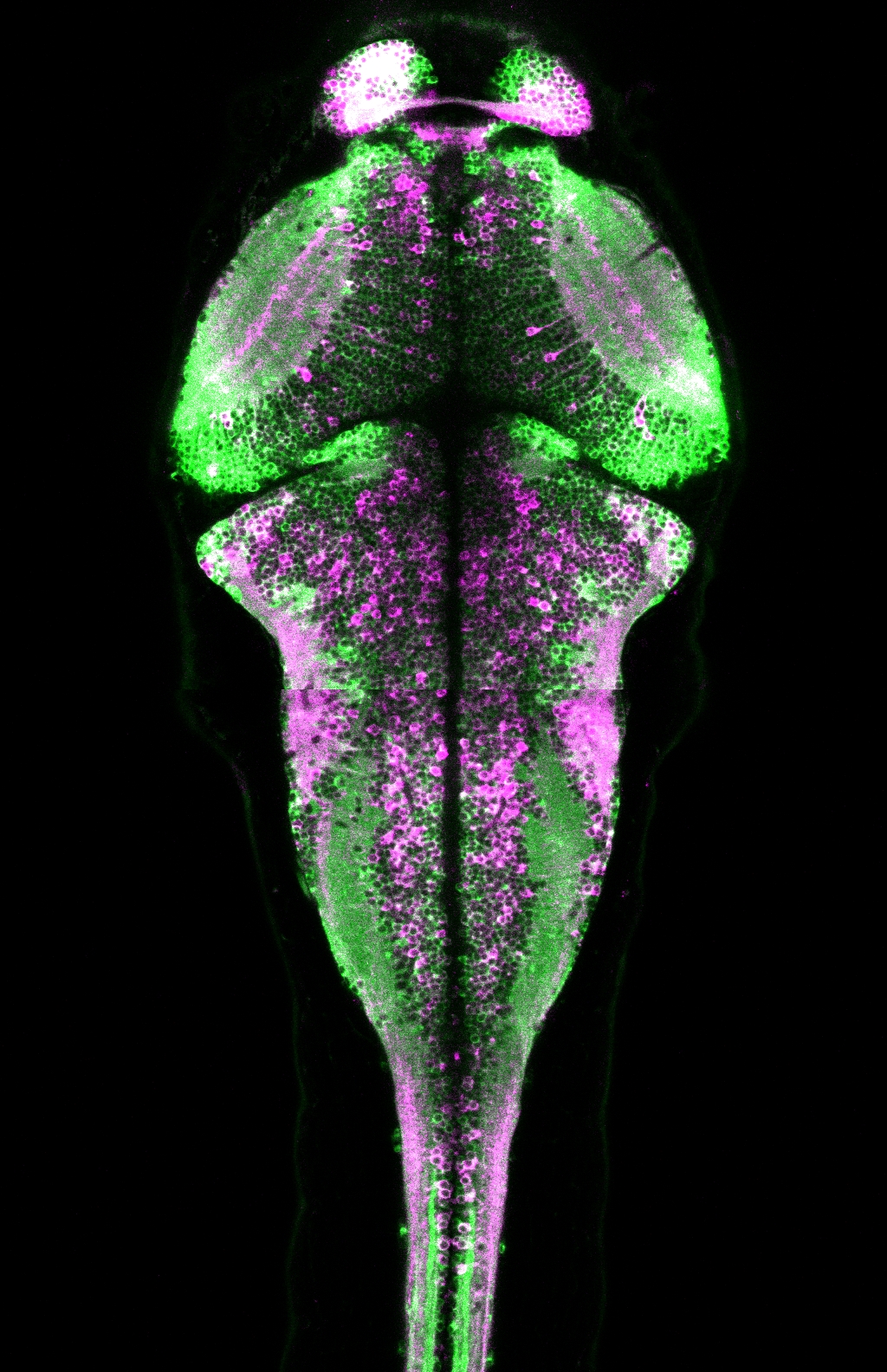Glowing Protein Reveals Animals' Brain Activity

With the help of a protein, researchers now have a more precise way to see brain activity — right down to what's going on in a single cell, in living brains.
A team of researchers at the Howard Hughes Medical Institute in Maryland has found a protein that binds to calcium particles in the brain and changes color from green to red as the brain cells become active.
The protein is called CaMPARI, for "calcium modulated photoactivatable ratiometric integrator.) Calcium ions carry electric charges in the nervous system, so their presence shows whether a given neuron is firing.
Researchers have been trying to find ways to track exactly which neurons are active in a living brain, but the search has been difficult. Functional magnetic resonance imaging (fMRI) is one way to show brain activity — it is based on the idea that blood flow in the brain corresponds with activity. But the resolution of the images made by fMRI is crude, with each illuminated pixel representing thousands of cells. In addition, blood flow is not always perfectly matched to brain activity; it takes some time for blood vessels to react to a change in brain activity, so the images do not show neural activity in real time.
Another method, which is aimed at letting researchers see the activity of individual cells, involves genes called immediate early genes (IEGs) that code for proteins that are only present when neurons are active. Researchers have found that they can teach an animal a task, and then look inside the animal's brain to see which of these proteins are present. However, it takes time for the cells to make the proteins, so the researchers still aren't able to see exactly when individual cells are active, said Eric Schreiter, a senior scientist at the Howard Hughes Medical Institute who led the new research. [6 Foods That Are Good For Your Brain]
A third method involves using molecules that bind to calcium that light up when neurons are active, but the problem there is that you have to have a microscope trained on the part of the brain you want. The animal also has to be restrained so its behavior is less natural.
In contrast, the CaMPARI protein in the new research binds to calcium and reacts immediately to neural activity, on the scale of milliseconds. Researchers can shine a violet light on the animal to get the protein to glow, so it's possible to observe living animals' brains in action. Further, scientists could use the CaMPARI protein to see exactly which neurons are active in an animal 5 seconds into a given activity, and then at 10 seconds, and so on.
Sign up for the Live Science daily newsletter now
Get the world’s most fascinating discoveries delivered straight to your inbox.
The researchers conducted experiments using the CaMPARI protein in zebrafish, fruit flies and mice, according to the report. To get the CaMPARI protein into the animals' brain cells, the scientists used an engineered virus that produced the protein once it had "infected" the cells. (The virus did not make the animals sick.)
In one experiment, the team put zebrafish in water of differing temperatures and turbulence. In another, they exposed fruit flies to different smells, and in another, the mice were shown a movie.
In each case, the research team lit up the animals' brains with violet light at certain times. The CaMPARI glowed either green or red, depending on how active the neurons were.
For the flies and zebrafish, the researchers only needed to bathe the animals in light, as their brain cases are thin and relatively transparent. To see the activity of the mice brains, the researchers had to cut a window into the skull of each animal.
Schreiter said other researchers had done work on proteins that bind to specific elements in neural cells, and from there, it was a short logical leap to find a protein that binds to calcium.
The researchers noted that this protein can't be used to study the human brain, because it requires a virus to be delivered and there isn't any accepted way to do that in humans yet.
But still, the method is a powerful tool, said Jerry Chen, a fellow at the Brain Research Institute at the University of Zurich in Switzerland, who was not involved in the study. The new report expands the repertoire of methods for brain scientists, he said.
"This allows us to now identify neurons whose activity relates to a single experience, and then go back and study those individual neurons more closely to understand how memory or [ideas] are encoded," Chensaid.
"It sort of puts together a couple of different approaches," said John Guzowski, an associate professor of neurobiology at the University of California, Irvine, who was not involved in the work. Techniques like this one are harder to scale up to bigger brains, he added, and there's the issue of binding to calcium. Calcium is the very ion that transmits electricity in brains, and when a protein binds to it, the calcium can't transfer the charge. Thus, in large amounts, something like CaMPARI can actually interfere with normal brain function, so future experimenters will have to account for that.
Schreiter acknowledged that this could be a problem. He said that further experiments with other proteins might reveal ways to track specific brain chemicals, such as dopamine, but the trick will be to find one that doesn't interfere too much with the brain chemicals themselves.
The study appears in the Feb. 13 issue of the journal Science.
Follow us @livescience, Facebook & Google+. Original article on Live Science.










